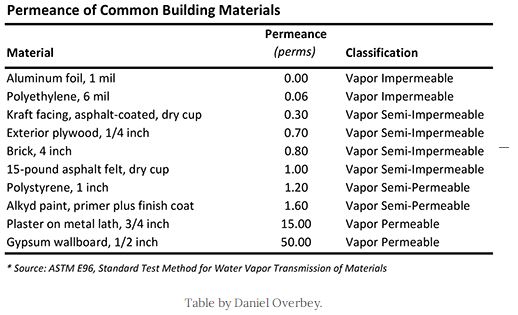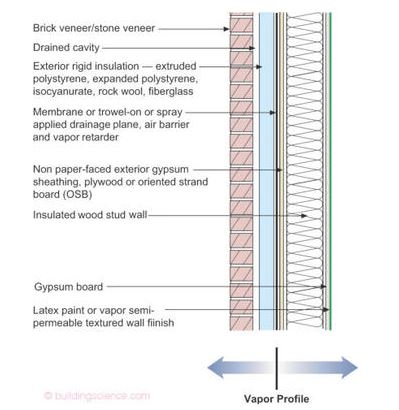Understanding Air Barriers and Vapor Retarders: Why and Where to Place Them
If you are endeavoring to build your own home or even just renovate part of it, most likely you want to do it right the first time. Here is some inspiration to plan well from workzone.com:
“By failing to prepare, you are preparing to fail.” ― Benjamin Franklin, Founding Father of the United States
“Every minute you spend in planning saves 10 minutes in execution; this gives you a 1,000 percent return on energy!” ― Brian Tracy, author and motivational speaker
“Give me six hours to chop down a tree and I will spend the first four sharpening the axe.” ― Abraham Lincoln, former U.S. President
It’s so true. One of my personal skills is the ability to paint walls well and enjoy doing it. I know that planning works because the best walls I have ever painted were the ones I spent 75% of the time preparing and 25% of the time painting. Planning ahead just makes the job so much more easy and successful.
Building something that you want to last is the same way: the investment of time and money is well worth it when the home just works. Layout and design seem to be the priority today, but function should take first place. It’s like choosing the color of the living room and buying that paint before any of the structural decisions have been made or executed. Does the roof work? Do the walls do their job? Does the foundation work? Let’s get those bones built and covered, so that they will protect all the beauty of form and life inside. (getting off my soapbox now).
Here is an article that is well worth reading: Building the Perfect Wall by Joe Lstiburek. Mr. Lstiburek argues that there are four barriers that need to be constructed to protect the home from the elements, and here they are in order of importance but not in order of installation.
- a rain control layer
- an air control layer
- a vapor control layer
- a thermal control layer
He also argues that all of these layers should be on the exterior of the structure (the bones, whether it’s wood or steel or concrete), because the structure is where the money is! Other than the rain control layer and maybe a vapor control layer, many builders do not recognize this. Putting the insulation on the outside of the structure? It’s just not done enough, but it’s brilliant. Here is a simplified diagram (buildingscience.com):
Here are some important points to understanding why these control layers are needed and why they have these priorities.
Rain control:
- Water does a lot of damage.
- UV light also does a lot of damage.
Air control:
- In order to control the interior environment, for the health of the building and its occupants, you must control the air. Controlling the air means making it air-tight, with controlled penetrations.
- Air can carry (transport) a lot of water: see the first point above about water doing a lot of damage.
Vapor control:
- Water vapor travels in two methods: air transport (see air control above) and vapor diffusion.
- Once again, in order to control the interior environment, you must control the vapor flow into and out of it.
Thermal control:
- Thermal control prevents condensation when the temperatures and dewpoints inside and outside of the home are different.
- One final word: Comfort!
Rain control and thermal control are relatively easy for me to understand; after all, every 4-season home now has siding and insulation. It took some digging to understand the limits of, and relationship between, air barriers and vapor retarders. It’s helpful to know that air barriers are actually rated in their ability to retard vapor, so that in modern buildings, air barriers are used as vapor retarders as well. (The term "vapor barrier" used to be in vogue but it's actually more accurate to use "vapor retarder"). There are two terms that relate to a material’s ability to retard vapor: permeability and permeance. To understand them, it’s helpful to know a little about water vapor.
Water vapor moves in two ways through a building: diffusion through the building materials themselves, and air transport. Here is a diagram illustrating the two:
Source: BuildingScience.com
Water vapor has its own pressure, which contributes to the total air pressure. The difference in vapor pressure between two sides of a building envelope assembly is the driving force behind vapor transmission by diffusion. (buildingenclosureonline.com)
Water vapor absorbs heat differently than the air in which it is mixed. If you think of sunshine streaming through a window and heating a room, the sun is heating air and water vapor in the room, but at different rates. Heat applied to the air raises its temperature directly (called sensible heat). Heat applied to the water vapor raises its temperature more slowly (also sensible heat), increases vapor pressure and with the increase in ambient temperature, also increases the ability of the air to hold more water vapor; thus it causes evaporation of any water in the room (from our skin for example) without changing its temperature (called latent heat). Sensible heat causes an increase in temperature, but latent heat causes a change in state without a change in temperature. (Latent heat is the heat applied to melt ice or boil water; the ice cube doesn’t change temperature while it’s melting and the water in a boiling pot does not change temperature while it’s boiling.) Vapor pressure will seek equilibrium, so that an area of high vapor pressure will try to diffuse to an area of lower pressure. It does this by “diffusing” through the wall itself. This movement is the reason for installing a vapor retarder.
Regarding air transport of water vapor, warm air naturally holds more moisture than cooler air, so you’ll want to prevent warm humid air from moving inward during summer, and warm air from moving outward during winter (causing condensation on the way in/out). The air barrier is responsible for stopping this movement.
Permeance describes the water vapor transmission rate (by diffusion). It is the rate over the course of one hour through one square foot of a material of a given thickness at a specified vapor pressure, expressed in perms (grams/hour●ft2●inches Mercury). (buildingenclosureonline.com) Since it deals with water vapor, permeance is also a description of how vapor retarders slow the transmission of latent heat.
Permeability in building materials is permeance per unit of thickness—or perm-inches, which is useful when comparing different thicknesses of insulation.
With the standard of Permeance, we are able to compare the vapor transmission qualities of different building materials. The less permeable a building material is, the greater its resistance to water vapor transmission. A vapor retarder is essentially any building material that exhibits a very low permeance (very high resistance to water vapor transmission). (buildingenclosureonline.com) Here is a table with some common building materials and their permeances:
Below is a diagram of The Perfect Residential Wall. The vapor arrows denote the desired flow of moisture because “we want the assembly to dry inwards from the control layers—and to dry outwards from the control layers.” (Joe Lstiburek, Building Science) You never, never, want to sandwich material between 2 vapor retarders. In effect, vapor will definitely be retarded there in that sandwich, causing condensation and mold!
Source: buildingscience.com
Note that this wall has two layers of insulation, which is ok, because the insulation is not trapping moisture (however it’s probably advisable not to insulation without kraft paper inside, more on that below). The external rigid insulation stops heat transfer to the wooden structure, and the internal insulation provides more comfort. The Perfect Wall article also describes a “clever wall” which combines all three: air, vapor and thermal control layers with one external layer of closed-cell high-density foam insulation.
Vapor retarders have evolved a lot over the course of just a few decades. From the early to the late 1900’s, roofing felt/tar paper was usually the only thing that went over the sheathing and behind the siding. There was no drainage behind the siding (and in most mid-grade homes, there is still none), and no air barrier. Sometimes the assembly worked well to protect the structure, and sometimes it did not, but without an air barrier, only moderate thermal control could be achieved inside. Also, the kraft-paper facing on fiberglass insulation is a permeable vapor barrier (see chart above).
Polyethylene was introduced as a vapor barrier in the 1950s (constructioncanada.net) and it had disastrous effects in many homes, because although it is a Class 1 Vapor Retarder (0.1 perm or less), correct placement of this layer was critical to avoid condensation issues. This brings us to our final point, where is the best place for the air barrier and vapor retarder?
The construction industry has had much confusion over where to place these layers. For a long time, installers were instructed to install the kraft paper facing of fiberglass insulation “facing the warm side”. They were also told (true today) to install it “facing them” meaning toward the interior of the building. What about southern buildings, which are cooler inside for most of the year, and cooler outside for only a few months? One can’t rearrange the insulation seasonally after the wall has been sealed up (!). The good thing is that kraft paper is semi-impermeable and, it turns out, is one of the earliest “smart” vapor retarders, meaning that it has variable permeance: low permeance in cooler, drier weather, and higher permeance in warmer, more humid weather. (greenbuildingadvisor.com) The newest vapor retarders are doing this to give a measure of flexibility to buildings in these swing climates. Some brand names are Intello Plus, Pro Clima DB+, and MemBrain (haha). Each of these products are marketed as air barriers AND vapor retarders, so that by installing one of them outside the structure (wood or metal or concrete), you are protecting the structure by slowing vapor diffusion through it and maximizing climatization inside the building by sealing air leakage. Since air sealing is ranked in priority above vapor retardation, it’s critical that the product be correctly and thoroughly installed to prioritize air sealing. For example, on a busy jobsite, different trades and change orders can make multiple unauthorized perforations in a properly installed air barrier, so signage protecting it and rules for authorizing penetrations must be given.
Since Youtube and Pinterest are the inspiration for many renovation projects, if you are taking on a renovation as a DIYer, and even when using a contractor, go back to the beginning of this article for more inspiration on planning. It does take extra time to read and research products and methods of installing air barriers and vapor retarders, but it’s oh-so-critical to get them right for the long-term health of your family and longevity of your home. Some recommended sites (in no particular order) are GreenBuildingAdvisor.com, BuildingScience.com, EnergyVanguard.com, Inspectapedia.com, BuildingEnclosureOnline.com, and more. Planning it well is more than half of building it well!
Photo by Daniel McCullough on Unsplash





